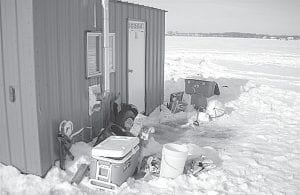For many Minnesotans there is nothing like walking on a frozen lake, carving a hole and pulling up an elusive fish from the depths below. When word gets out that there’s a good fish bite on a lake, ice anglers descend on the spot. Unfortunately, that pristine environment sometimes becomes littered with bottles, cans, cigarette butts, or worse.
As the season winds down, Minnesota Department of Natural Resources (DNR) conservation officers remind fishermen to clean up around their fish houses.
Litter is a petty misdemeanor criminal charge with a fine of up to $300. Conservation officers also have solid waste civil citation authority. These civil citations are “by the pound” or “by the cubic foot” penalties, and since they are not criminal charges, they don’t require proof beyond a reasonable doubt. The person suspected of littering must pay the penalty and clean up the mess.
However, COs sometimes have a hard time identifying the perpetrators.
“Lakes are normally ringed by fish houses during the year so conservation officers find it challenging to identify who is leaving trash on a lake,” said Capt. Ken Soring, DNR Enforcement northeast regional manager in Grand Rapids. “Another factor is the wind, which makes it difficult to prove where the trash came from. And we just don’t have enough conservation officers to thoroughly enforce litter laws.”
The DNR offers the following tips to keep Minnesota waterways clean: set an example for others, especially children, by not littering, Properly dispose of tangled fishing line to prevent wildlife from being trapped and injured. Remember it is unlawful to dispose of ice fishing shacks anywhere in the state. Keep a litter bag or trash container in your fish house, dark house, or shelter; secure trash container covers to prevent wind or animals from spreading litter; cover and secure any vehicle, truck, or trailer carrying refuse; and when visiting any recreation area, make sure to leave the area clean for the next person to enjoy.



Loading Comments